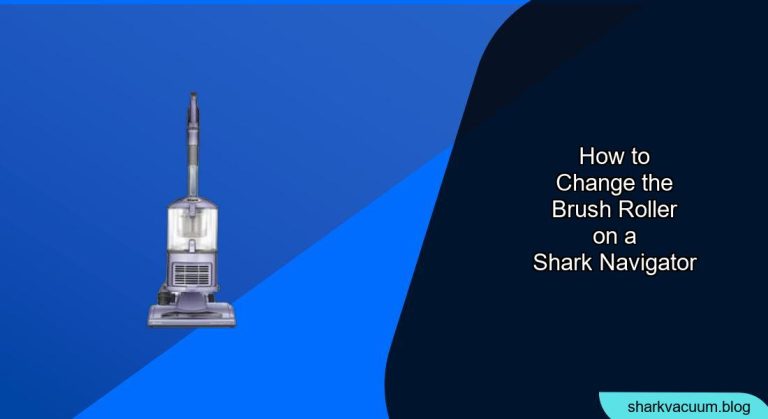Changing the brush roller on your Shark Navigator vacuum is a simple maintenance task that can significantly improve your vacuum’s performance. A worn or damaged brush roller can reduce suction and cleaning effectiveness, so replacing it when necessary is crucial. This guide provides a step-by-step walkthrough to help you easily replace the brush roller on your Shark Navigator, ensuring your vacuum continues to deliver optimal cleaning power.
This guide matters because a well-maintained brush roller ensures your Shark Navigator operates efficiently, picking up dirt, dust, and debris effectively from your floors. By following these instructions, you’ll extend the life of your vacuum and maintain a cleaner home. This article provides a clear and concise guide on how to safely and correctly change the brush roller on your Shark Navigator vacuum cleaner. We will cover everything from preparing your vacuum to troubleshooting common issues you might encounter during the replacement process.
Table of Contents
What You’ll Need
- New brush roller (Ensure it’s compatible with your Shark Navigator model)
- Screwdriver (usually a Phillips head)
- Scissors or a seam ripper (to cut away any tangled hair or debris)
- Gloves (optional, to keep your hands clean)
Step-by-Step Guide to Changing the Brush Roller
- Power Off and Unplug:
- Before you begin, ensure your Shark Navigator is powered off and unplugged from the electrical outlet. This is a crucial safety step to prevent any accidental injuries during the maintenance process.
- Locate the Brush Roller Access:
- Identify the brush roller access plate on the vacuum head. This is usually located on the underside of the vacuum head and is secured by screws.
- Different Shark Navigator models may have slightly different access plate designs, so consult your vacuum’s manual if needed.
- Remove the Access Plate:
- Use a screwdriver to remove the screws securing the access plate. Place the screws in a safe place to avoid losing them.
- Carefully detach the access plate to expose the brush roller.
- Remove the Old Brush Roller:
- Gently lift the old brush roller out of the vacuum head.
- If the brush roller is stuck or tangled with hair and debris, use scissors or a seam ripper to carefully cut away the obstructions. Be cautious not to damage the vacuum head or the brush roller housing.
- Clean the Brush Roller Housing:
- Before installing the new brush roller, thoroughly clean the brush roller housing. Remove any accumulated dust, hair, or debris that may impede the new brush roller’s performance.
- Use a small brush or a cloth to wipe the interior of the housing and ensure it is free from obstructions.
- Install the New Brush Roller:
- Insert the new brush roller into the housing, ensuring it is properly aligned. The brush roller should fit snugly and rotate freely.
- Make sure the brush roller is correctly seated in its designated slots or bearings within the vacuum head.
- Reattach the Access Plate:
- Place the access plate back onto the vacuum head, aligning it with the screw holes.
- Use the screwdriver to re-secure the access plate with the screws you removed earlier. Ensure the screws are tightened properly to keep the access plate in place.
- Test the Vacuum:
- Plug the vacuum back into the electrical outlet and turn it on to test the new brush roller.
- Ensure the brush roller spins freely and operates smoothly. Listen for any unusual noises that may indicate improper installation.
Practical Elements

Tools/Materials:
- New Brush Roller: Shark Navigator Replacement Brushroll -check your model number to ensure compatibility.
- Phillips Head Screwdriver: A standard screwdriver will work.
- Scissors: Fiskars Recycled Softgrip Scissors.
- Gloves: Disposable Nitrile Gloves.
Preparation Steps:
- Read the Manual: Consult your Shark Navigator’s manual for specific instructions related to your model.
- Gather Tools: Ensure you have all the necessary tools and materials ready before starting.
- Clear Workspace: Work in a well-lit area with enough space to maneuver and keep parts organized.
Troubleshooting Guide:
- Brush Roller Not Spinning:
- Problem: The new brush roller does not spin after installation.
- Solution:
- Ensure the brush roller is properly seated in the housing.
- Check for any obstructions preventing the brush roller from spinning.
- Verify that the access plate is securely attached and not interfering with the brush roller’s movement.
- Unusual Noises:
- Problem: The vacuum makes unusual noises after replacing the brush roller.
- Solution:
- Recheck the brush roller installation to ensure it is correctly aligned.
- Inspect the brush roller housing for any loose parts or debris.
- Make sure the access plate is properly tightened.
- Reduced Suction:
- Problem: The vacuum has reduced suction after replacing the brush roller.
- Solution:
- Ensure the brush roller is spinning at the correct speed.
- Check for any clogs in the vacuum hose or filters.
- Verify that the brush roller bristles are not worn or damaged.
- Access Plate Difficult to Remove:
- Problem: The access plate is difficult to remove due to stuck screws.
- Solution:
- Use a screwdriver with a better grip or apply penetrating oil to loosen the screws.
- Ensure you are using the correct size screwdriver to avoid stripping the screw heads.
- If necessary, seek assistance from a professional repair service.
Pro Tips:
- Regular Cleaning: Clean the brush roller regularly to prevent hair and debris buildup.
- Gentle Handling: Handle the brush roller and access plate with care to avoid damage.
- Correct Alignment: Ensure the brush roller is correctly aligned during installation to ensure proper function.
Alternatives/Variations:
- Professional Service: If you are uncomfortable performing the replacement yourself, consider seeking assistance from a professional vacuum repair service.
- Upgraded Brush Roller: Explore upgraded brush roller options that may offer improved performance or durability.
- Preventative Maintenance: Implement a regular maintenance schedule to prolong the life of your brush roller and vacuum.
FAQ Section:
How often should I change my Shark Navigator brush roller?
It is generally recommended to change your Shark Navigator brush roller every 6 to 12 months, depending on usage and the amount of dirt and debris it encounters. Regular inspection can help you determine when a replacement is necessary, especially if you notice reduced cleaning performance.
Can I use a generic brush roller instead of a Shark-branded one?
While generic brush rollers may be available, using a Shark-branded brush roller ensures compatibility and optimal performance. Generic options may not fit correctly or provide the same level of cleaning power, potentially damaging your vacuum cleaner.
What are the signs that my brush roller needs to be replaced?
Signs that your brush roller needs replacing include reduced suction, visible wear or damage to the bristles, unusual noises during operation, and a decrease in overall cleaning effectiveness. If you notice any of these issues, inspect your brush roller and consider replacing it.
How do I clean my Shark Navigator brush roller to prolong its life?
To clean your Shark Navigator brush roller, first, turn off and unplug the vacuum. Then, remove the brush roller and use scissors or a seam ripper to cut away any tangled hair or debris. Wipe the brush roller with a clean cloth and ensure it is completely dry before re-installing it.
What type of screwdriver should I use to remove the access plate?
Generally, a Phillips head screwdriver is required to remove the access plate on most Shark Navigator models. Ensure you use the correct size screwdriver to avoid stripping the screw heads. If the screws are tight, apply some pressure and turn slowly.
Is it difficult to change the brush roller on a Shark Navigator vacuum cleaner?
Changing the brush roller on a Shark Navigator vacuum cleaner is generally not difficult and can be done in a few simple steps. By following the step-by-step guide provided, you can easily replace the brush roller yourself, saving time and money on professional repairs.
Tips, Warnings, and Best Practices:
- Safety First: Always unplug the vacuum cleaner before performing any maintenance tasks.
- Read the Manual: Refer to your Shark Navigator’s manual for specific instructions and safety guidelines.
- Proper Tools: Use the correct tools to avoid damaging the vacuum cleaner or injuring yourself.
- Regular Cleaning: Clean the brush roller regularly to maintain optimal performance and prolong its life.
- Inspect Regularly: Check the brush roller for wear and damage regularly and replace it as needed.
- Professional Help: If you are unsure about any step, seek assistance from a qualified technician.
Conclusion:
Replacing the brush roller on your Shark Navigator vacuum is a straightforward process that can significantly improve its cleaning performance. By following this guide, you can easily maintain your vacuum and ensure it continues to effectively remove dirt and debris from your floors. Regular maintenance, including brush roller replacement, is essential for prolonging the life of your Shark Navigator and keeping your home clean. Take the next step and inspect your brush roller today to ensure your vacuum is operating at its best, keeping your home spotless.







